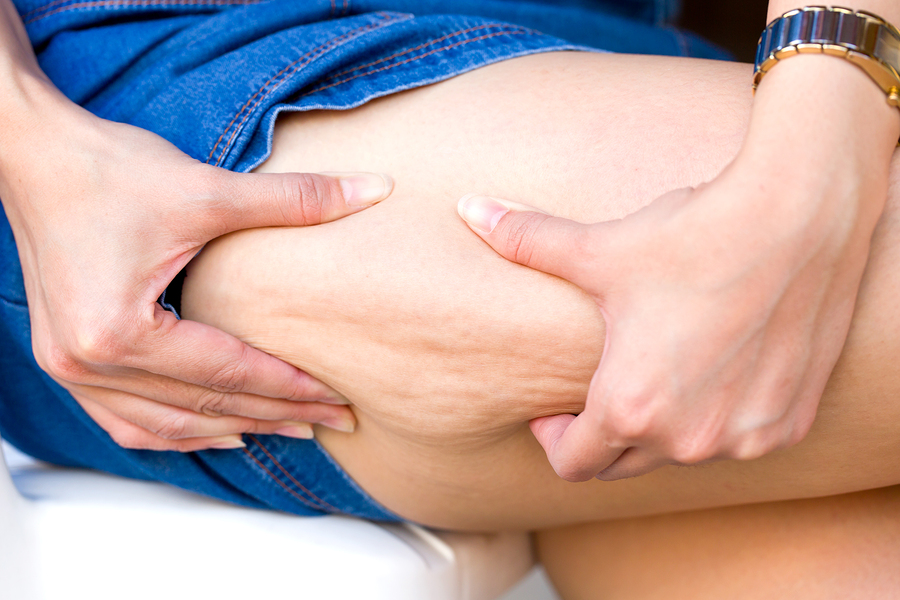(Editor’s Note: Hey guys, check out this great article by my friend and also follow this link to register for The Detox Project, a summit that I’m speaking at- with my better half!)
By Dr. B.J. Hardick
You’ve heard the slurs and you probably don’t like them. Cottage cheese skin. Orange peel. Hail damage. Despite its derogatory terms, cellulite is no laughing matter for those troubled by it. Dermatologists report that up to 90 percent of women and 10 percent of men have cellulite. Rest assured, no one has ever died from cellulite … but a few mirrors may have been smashed over it.
The industry is full of crackpot remedies lacking any scientific backing — but there is good news. The notion that nothing works against cellulite is an absolute myth. If you have a product graveyard under your bathroom sink full of anti-cellulite relics that got you nowhere, you’re in good company. Truthfully, however, there are simple evidence-based strategies that actually target the cause of the problem.
What Causes Cellulite?
There is much debate about the cause of cellulite. Although it probably results from a combination of factors — genetics, hormone variations, poor diet, poor circulation, excess body fat, overstressed liver — I believe one factor towers above the rest: trapped toxins.
Cellulite results from lazy lymphatic and circulatory systems that cause the body to hold on to toxins — and our bodies store toxins in fat. Toxins stored in subcutaneous fat damage the skin’s architecture, giving rise to those lumps and bumps.
In the upper layer of your subcutaneous skin, you have oblong “fat chambers” that are separated and supported by collagen-rich connective fibers. As you age, these fibers become thinner, weaker and less rigid. Lazy lymph and sluggish venous flow allow waste products and blood pressure to build, and this weakens vessel walls and causes blood to seep into surrounding tissues. Accumulated toxins damage the connective fibers that hold together those little fat chambers. Fat cells that should have been confined to your skin’s subcutaneous layer swell up and protrude into the dermis layer — and what you get is the puckered skin known as cellulite.
Chronic dehydration and inactivity lead to fluid retention, which makes cellulite even more pronounced. Recent research shows that cellulite contains more water-attracting molecules than smooth skin, which only worsens water retention. Plus, fluids accumulating around cells deprives them of nourishment, further compounding the problem.
Why is Cellulite So Common Among Women?
I hate to say it, but women’s bodies are biologically “primed” to accumulate fat. For starters, women have more fat layers than men, plus a less dense collagen network, higher estrogen levels, and more alpha receptors. If you’re a woman battling cellulite, all of this is working against you.
Men have just one layer of fat throughout their entire body, but women have three layers in certain areas (hips, knees, triceps and abdominal region). Men also have a denser and firmer fiber network in their dermis layer, which helps resist those bulging fat cells.
Women’s hormones also play a role. Women typically begin developing cellulite soon after puberty under the influence of estrogen. Estrogen creates fat whereas testosterone breaks it down. Cellulite may worsen in women’s mid-twenties to mid- thirties as estrogen levels begin to decline, because estrogen enhances circulation. As women age, decreased circulation leads to decreased tissue oxygenation, therefore diminished collagen formation.
The fourth strike against women is “Mars and Venus” alpha adrenergic receptors. Amidst the many functions of alpha and beta receptors, think about it this way: Alpha receptors tell fat cells to make fat, whereas beta receptors tell them to break down fat. Men have a one-to-one ratio of alpha to beta receptors, but women’s thighs contain nine alpha receptors for every one beta receptor.
All of this means that, if you’re a woman struggling with cellulite, it may not be your fault — you’re certainly not getting any help from your biology. Many women try to exercise it off, which may seem logical, but for many women it makes only a small difference or sadly none at all.
What You Need to Know About Exercise
Exercise has many benefits — almost too many to count — but when it comes to cellulite, its power is limited. Exercise strengthens your muscles but not your
subcutaneous collagen structure. If your cellulite is the result of a high toxic load, then it’s a toxicity problem rather than a fitness problem and no amount of exercise alone is going to resolve it — you have to detox.
Exercise is required to keep your lymph moving. Lymphatic drainage is critical for detoxification because, unlike your circulatory system, your lymphatic system has no “heart” to keep it flowing, only body movement. So in regard to detoxification, movement is necessary, but this is only one piece of the puzzle. Another piece is leptin resistance.
Fat doesn’t make you fat — it’s the inability to burn fat that makes you fat, which may be caused by leptin resistance. Studies show women are more sensitive to leptin levels than men, and toxins can disrupt leptin signaling. Toxins are fat soluble and have an affinity for fat cells. They attach themselves to cell membranes and cause those cells to over-secrete leptin, which results in leptin resistance.
These toxins also release cytokines that damage leptin receptors in your brain, and once those are damaged, weight loss and cellulite reduction are very difficult.
If you’re on toxic overload, exercise may even backfire because it places additional stress on the body. In this case it’s helpful to let your body heal for a while before adding in much exercise, especially strenuous exercise. Once your tolerance has increased, high-intensity training in short bursts has been shown to be more effective than traditional cardio for restoring leptin sensitivity.
12 Tips for Outsmarting Cellulite
Now that you have a better understanding of what you’re dealing with, here are my top 12 skin-smoothing strategies for eliminating those stubborn lumps and bumps. This protocol is not a quick-fix but rather works over time to improve your body’s detoxification processes, lymphatic flow, liver function, microcirculation and collagen synthesis. The more of these you can build into your daily routine, the faster that nasty cellulite will disappear.
1. Eliminate sugar and toxic foods
Processed foods are loaded with sugar, unhealthy fats and chemical additives. Increase your consumption of healthy fats while reducing carbohydrates and starches, and switch from conventionally raised to pasture-raised animal products. Include plenty of organic, nutrient-packed, moisture-rich foods such as cucumbers, radishes, strawberries and other fresh fruits and vegetables. Be mindful of the overall sugar content from fruits, especially if you have insulin resistance and/or a tendency to gain weight. For additional tips, please refer to my Core Nutrition Plan.
2. Cran-Water
The phytonutrients in cranberries, as well as other colorful fruits and vegetables, have been shown to reduce fluid buildup in tissues. Proanthocyanidins (a group of polyphenols) strengthen your connective tissue and protect your blood vessel walls from oxidative damage, especially those delicate capillaries. Cranberry juice is packed with flavonoids, enzymes and organic acids such as malic acid, citric acid, and quinic acid, which help emulsify the fat globules in your lymphatic system.
Nutritionist Ann Louise Gittleman, author of The Fat Flush Plan, swears by her signature beverage: Flat Flush Cran-Water. You can make this by adding one ounce of unsweetened cranberry juice to seven ounces of water, and sip on it throughout the day.
3. Bone Broth
A basic constituent of bone broth is collagen, which helps rebuild connective tissue, including those supportive fibers that help keep fat cells contained.
4. L-Carnitine
L-carnitine’s primary role is to transport broken-down fats (fatty acids) into your cells to be “burned” by your mitochondria for energy.
5. CLA (Conjugated Linoleic Acid)
CLA promotes fat-burning and reduces the amount of fat that gets stored. Studies have shown CLA effective in reducing body fat, including the type giving rise to cellulite.
6. Lecithin
Lecithin is a rich source of choline (in the form of phosphatidylcholine), B vitamins and inositol. Lecithin stimulates bile production and promotes fat breakdown in your liver. When your liver is clear, it can more easily metabolize fat from your belly, hips and thighs. Lecithin is also highly beneficial for your brain — which is actually comprised of 30 percent lecithin. Add a couple tablespoons of non-GMO lecithin to water or juice every day, or sprinkle the granules over food.
7. Liver Support
The more love you can give to your liver, the better your detoxification will be. Several herbs are beneficial for the liver, as well as lipotropic, including dandelion root, milk thistle, cilantro and Oregon grape root. Roasted dandelion root tea is delicious.
8. Dry Brushing
Give cellulite the brush off! Dry brushing the skin increases circulation and lymphatic drainage and softens shallow fat deposits, which helps diminish cellulite. Brushes are widely available for about $10 to $20. For complete instructions, see Erin’s dry brushing guide.
9. Massage
Various types of massage have proven effective against cellulite, including manual massage, manual lymphatic drainage, and connective tissue manipulation. Some of these you can learn to do yourself.
10. Rebounding
Lazy lymph requires increased physical movement. Gentle bouncing is one of the safest and most effective ways to stimulate your lymphatic system. Consider the use of a rebounder (mini-trampoline). Start with gentle bouncing for a minute or two, several times a day, and you can work up to longer sessions of more energetic bouncing. Lymph is stimulated even if your feet don’t leave the rebounder, so this does not have to be a “no pain, no gain” sort of thing to be effective.
11. Caffeine
Caffeine is one of the most common agents in cellulite creams. Remember those alpha receptors? Caffeine blocks some of their fat-making activities by inhibiting the enzyme phosphodiesterase. One study found topical application of caffeine reduced the diameter of fat cells by 17 percent in female mice. A coffee scrub can tone the skin by increasing circulation and decreasing fluid congestion, as well as delivering collagen-boosting antioxidants. Keep in mind that the effects of topical cellulite treatments are temporary.
Elle has a simple recipe for a cellulite scrub you can make at home. Combine one cup of coffee grounds with six tablespoons of coconut oil and three tablespoons of sea salt (or sugar). Store in a waterproof glass jar. In the shower, massage it into affected areas using a circular motion.
12. Retinol/Vitamin A
Retinol is another ingredient commonly added to cellulite creams for its collagen-building properties. In one study, six months of retinol treatment resulted in a two- to five-fold increase in the number of fibrous strands in the skin of women with mild to moderate cellulite.
None of the above are quick fixes. They work best when used synergistically. Don’t expect results by this weekend or your vacation next month. But, long-term, know that when you have effectively addressed cellulite that you’ve effectively addressed deeper hormonal and toxicity issues, for which your body will forever thank you.
1. Gittleman AL. “Reversing Cellulite” August 8, 2014
2. Harmon K. “Is Cellulite Forever?” May 4, 2009 Scientific American
3. Gittleman AL. “Fat Flush Water” August 2, 2012
4. Rawlings AV. “Cellulite and its treatment.” Int J Cosmet Sci. 2006 Jun;28(3):175-90 PMID: 18489274 DOI: 10.1111/j.1467-2494.2006.00318.x
5. Thom E et al. “Conjugated Linoleic Acid Reduces Body Fat in Healthy Exercising Humans” Journal of International Medical Research October 2001;29(5): 392-396 doi: 10.1177/147323000102900503
6. Bayrakci Tunay V et al. “Effects of mechanical massage, manual lymphatic drainage and connective tissue manipulation techniques on fat mass in women with cellulite.” J Eur Acad Dermatol Venereol. 2010 Feb;24(2):138-42 PMID: 19627407 DOI: 10.1111/j.1468-3083.2009.03355.x
7. Velasco MV et al. “Effects of caffeine and siloxanetriol alginate caffeine, as anticellulite agents, on fatty tissue: histological evaluation.” J. Cosmet Dermatol. 2008 Mar;7(1):23-9. PMID: 18254807 DOI: 10.1111/j.1473-2165.2008.00357.x
8. Bertin C et al. “A double-blind evaluation of the activity of an anti-cellulite product containing retinol, caffeine, and ruscogenine by a combination of several non-invasive methods.” J Cosmet Sci. 2001 Jul-Aug;52(4):199-210. PMID: 11479653
9. Vogelgesand B et al. “In vitro and in vivo efficacy of sulfo-carrabiose, a sugar-based cosmetic ingredient with anti-cellulite properties.” Int J Cosmet Sci. 2011 Apr;33(2):120-5. PMID: 20807262 DOI: 10.1111/j.1468-2494.2010.00593.x
10. Dawson Hoff V. “How to Get Rid of Cellulite With a Homemade Coffee Scrub.” May 2, 2016 Elle
 Raised in a holistic family, Dr. B.J. Hardick is an organic food fanatic and green-living aficionado who has spent the majority of his life working in natural healthcare. He wrote his first book in 2009, Maximized Living Nutrition Plans, which has now been used professionally in over 500 health clinics, alongside a follow-up publication to which he was a contributor, The Cancer Killers. Dr. Hardick is on the advisory board for GreenMedInfo, the world’s most widely-referenced, natural health database. www.DrHardick.com
Raised in a holistic family, Dr. B.J. Hardick is an organic food fanatic and green-living aficionado who has spent the majority of his life working in natural healthcare. He wrote his first book in 2009, Maximized Living Nutrition Plans, which has now been used professionally in over 500 health clinics, alongside a follow-up publication to which he was a contributor, The Cancer Killers. Dr. Hardick is on the advisory board for GreenMedInfo, the world’s most widely-referenced, natural health database. www.DrHardick.com 











